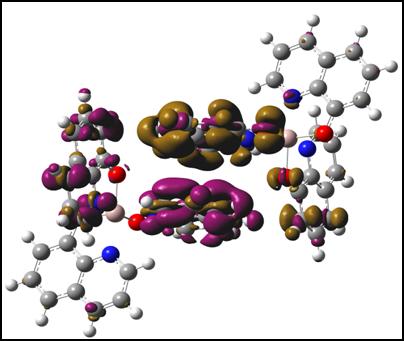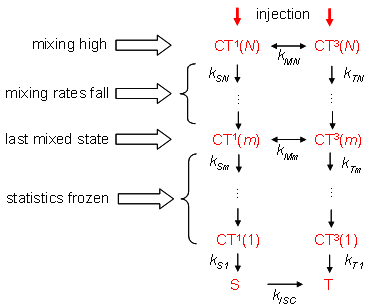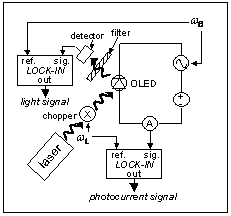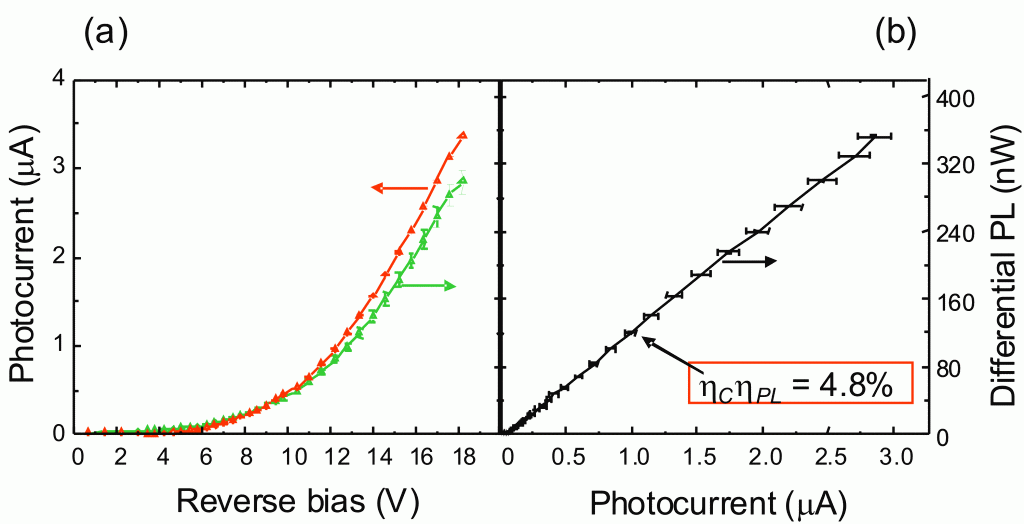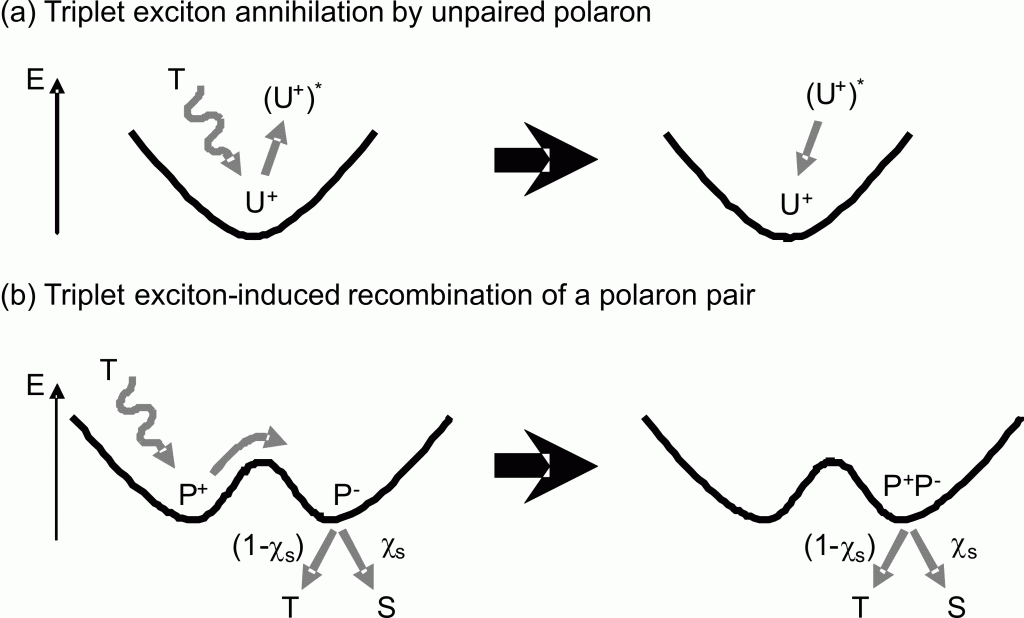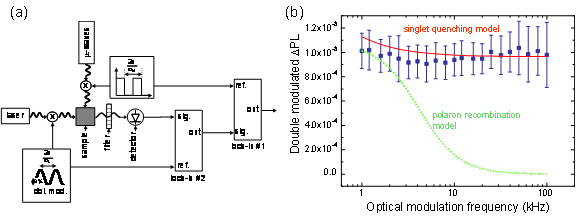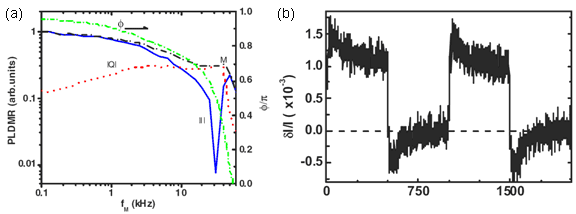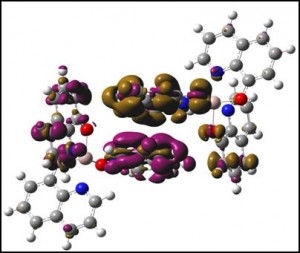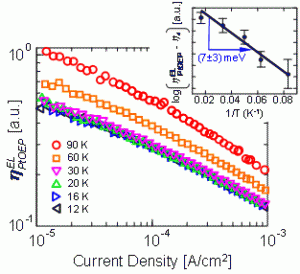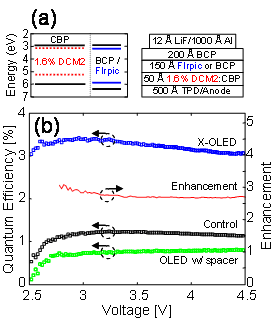Research
Measuring and Controlling Exciton Spin in Organic Semiconductors
M. Segal and M.A. Baldo
Sponsorship: NSF, MRSEC and 3M
Collaborators: Joseph Shinar, Iowa State University; Zoltan Soos, Princeton University; Troy Van Voorhis, MIT Chemistry Department
Introduction
Organic light emitting devices (OLEDs) are perhaps the most important application of organic semiconductors. OLEDs can be understood as machines that convert injected charges into excitons. An exciton is a molecular excited state that mediates the emission of light. Each exciton may take may one four possible spin states: three “triplet” states of total spin 1, or one “singlet” state of total spin 0. The ground state is also a singlet in the vast majority of molecules. Thus, the efficiency of radiation from an exciton is typically spin-dependent. The decay of the singlet exciton is allowed, yielding radiation known as fluorescence. The decay of the triplet exciton is usually disallowed. When it occurs at all, radiation from triplet states is slow and known as phosphorescence.
‘Extrafluorescence’ is perhaps the most important result. We have demonstrated the ability to manipulate the fraction of excitons which form as singlets in fluorescent materials by altering the OLED structure. We have built a fluorescent OLED showing an approximately three-fold increase in singlet fraction and fluorescent efficiency. Extrafluorescence may help address the challenge of producing efficient, stable and saturated blue light with organic semiconductors.
We are concerned with the fraction of singlet excitons, χ, which determines the fundamental efficiency limit of fluorescent OLEDs. Our work has had four major outcomes:
- A theory of exciton formation
- Determination of the fundamental efficiency limit in fluorescent OLEDs
- Explanation of magnetic resonance phenomena in organic semiconductors
- ‘Extrafluorescence’– A demonstration of control over exciton formation
Relevant Publications
- M. Segal, M. Singh, K. Rivoire, S. Difley, T. Van Voorhis, M.A. Baldo “Extrafluorescent Electroluminescence in Organic Light Emitting Devices,” Nature Materials 6, 374-378 (2007).
- M.A. Baldo, M. Segal, J. Shinar, Z.G. Soos, “Reply to ‘Comment on ‘Frequency response and origin of the spin-1/2 photoluminescence-detected magnetic resonance in a pi-conjugated polymer’ ’ “, Phys. Rev. B 75, 246202 (2007).
- M.K. Lee, M. Segal, Z. G. Soos, J. Shinar and M.A. Baldo, “Reply to ‘Comment on ‘Yield of Singlet Excitons in Organic Light Emitting Devices’ ’ ”, Physical Review Letters 96(8) (2006).
- M. Segal, M.A. Baldo, M.K. Lee, J. Shinar, and Z.G. Soos, “Frequency response and origin of the spin-1/2 photoluminescence-detected magnetic resonance in a pi-conjugated polymer,” Phys. Rev. B 71, 245201 (2005).
- M.K. Lee, M. Segal, Z.G. Soos, J. Shinar and M.A. Baldo, “On the Yield of Singlet Excitons in Organic Light-Emitting Devices: A Double Modulation Photoluminescence-Detected Magnetic Resonance Study,” Phys. Rev. Lett. 94, 137403 (2005).
- M.A. Baldo and M. Segal. ‘Phosphorescence as a Probe of Exciton Formation and Energy Transfer in Organic Light Emitting Diodes.’ Physica Status Solidi A. 201. 1205-1214 (2004).
- M Segal and M.A. Baldo, “Reverse bias measurements of the photoluminescent efficiency of semiconducting organic thin films,” Organic Electronics 4, 191-197 (2003).
- M. Segal, M.A. Baldo, R.J. Holmes, S.R. Forrest, and Z.G. Soos, “Excitonic singlet-triplet ratios in molecular and polymeric organic materials,” Physical Review B 68 (7), 075211 (2003).
Theory of exciton formation
Excitons are generated electrically when opposite charges combine on a single molecule to form an excited state. The precursor state to the exciton is the charge transfer or “CT” state, which consists of an electron and hole on two adjacent molecules, as in Fig. 1.
Fig. 1 – The calculated charge density difference between the singlet and triplet CT states, and the ground state, in aδ -AlQ3 dimer. The right (left) hand molecule is constrained to be negatively (positively) charged, and gold (purple) surfaces enclose volumes where the CT state has more (fewer) electrons. The singlet CT state is calculated to be lower in energy than the triplet CT state by 70 meV.[7]
Literature calculations of the fraction χ of excitons that form as singlets have considered the formation rates of singlet and triplet excitons from CT states, but not the mixing rates of singlet and triplet CT states.[1-6] Fig. 2 explicitly considers these rates. The key observation behind this model is that the mixing rate kM falls as the charges approach each other. This is due to larger exchange effects, which lead to an increasing energy barrier to mixing. Mixing effectively turns off for charge pairs separated by less than some number of molecules m. Spin statistics are then determined by the rates kSm and kTm, rather than kS1 and kT1. Our data indicates that 1 < m < 5.[7]
Fig. 2 – A rate model for the electrical formation of excitons. Positive and negative charges are injected into an OLED from distant contacts, and form either singlet (CT1) or triplet (CT3) states. The charges are initially separated by N molecules and hop together, singlets with rate kS and triplets with rate kT. The charge pairs can also switch spin with rate kM. Eventually, they form singlet or triplet excitons, S or T.
References
- M. Wohlgenannt, Kunj Tandon, S. Mazumdar et al., “Formation cross-sections of singlet and triplet excitons in pi-conjugated polymers,” Nature 409, 494-497 (2001).
- Z. Shuai, D. Beljonne, R.J. Silbey et al., “Singlet and Triplet Exciton Formation Rates in Conjugated Polymer Light-Emitting Diodes,” Phys. Rev. Lett. 84 (1), 131-134 (2000).
- K. Tandon, S. Ramasesha, and S. Mazumdar, “Electron correlation effects in electron-hole recombination in organic light-emitting diodes,” Phys. Rev. B 67, 045109 (2003).
- S. Karabunarliev and E.R. Bittner, “Spin-dependent electron-hole capture kinetics in luminescent conjugated polymers,” Phys. Rev. Lett. 90, 057402 (2003).
- M. N. Kobrak and E. R. Bittner, “Quantum molecular dynamics study of polaron recombination in conjugated polymers,” Phys. Rev. B 62 (17), 11473-11486 (2000).
- T. M. Hong and H. F. Meng, “Spin-dependent recombination and electroluminescence quantum yield in conjugated polymers,” Phys. Rev. B 6307 (7) (2001).
- M. Segal, M. Singh, K. Rivoire, S. Difley, T. Van Voorhis, M.A. Baldo “Extrafluorescent Electroluminescence in Organic Light Emitting Devices,” Nature Materials 6, 374-378 (2007).>
Measuring The Singlet Fraction
Fig. 1 shows the method we have developed for measuring the spin statistics in an organic luminescent material.[1] An OLED is fabricated with the material of interest serving as its luminescent layer, and two types of efficiencies are measured. First, the OLED is operated normally, with injected electrons and holes combining to form both singlets and triplets in the ratio χ : (1-χ). Only the singlets emit light. The ratio of the measured luminescence to the driving current gives the electroluminescent (EL) efficiency. Then, the OLED is operated in reverse bias while exposed to an optical pump, which generates only singlet excitons. The reverse bias electric field breaks some singlet excitons into electrons and holes, producing photocurrent and reducing the photoluminescence (PL) by an amount ΔPL. The ratio of ΔPL to the photocurrent then gives the PL efficiency. The singlet fraction χ is then simply the ratio of EL to PL efficiency.
Fig. 1 – The experimental setup of the spin statistics measurement. When the OLED is operated in forward bias, EL is collected by the detector. Spin statistics are determined by comparing the EL to the PL efficiency as determined by photoexciting the OLED under reverse bias. The photocurrent is detected synchronously with the optical chopping frequency, and the PL is locked to the modulation frequency of the reverse bias voltage. This scheme rejects leakage current and optical pump fluctuation.
This measurement technique has the advantage that it is a relative measurement: because the singlet ratio is derived from a ratio of efficiencies, not every photon must be captured, as in many other measurements. In addition, the shape of the ΔPL versus photocurrent characteristic reveals possible degradation of the luminescent material.[2] A degraded material may otherwise yield artificially high singlet ratios.
Applying this technique to the archetypal small molecular weight luminescent material tris(8-hydroxyquinoline) aluminum (Alq3) yielded a singlet fraction of (20±1)%, in agreement with previous studies.[3] The archetypal luminescent polymer poly[2-methoxy-5-(2-ethylhexyloxy)-1,4-phenylenevinylene] (MEH-PPV) yielded a singlet fraction of (20±4)%, in disagreement with other studies which have found it to be well above 25%.[4,5]
Fig. 2 – (a) Synchronously-detected photocurrent and the corresponding decrease in PL for the polymer MEH-PPV as a function of reverse bias. (b) The relationship between the decrease in PL and photocurrent gives the synchronously-detected out-coupled PL efficiency.
References
- M. Segal, M.A. Baldo, R.J. Holmes et al., “Excitonic singlet-triplet ratios in molecular and polymeric organic materials,” Physical Review B 68 (7), 075211 (2003).
- M Segal and M.A. Baldo, “Reverse bias measurements of the photoluminescent efficiency of semiconducting organic thin films,” Organic Electronics 4, 191-197 (2003).
- M.A. Baldo, D.F. O’Brien, M.E. Thompson et al., “Excitonic singlet-triplet ratio in a semiconducting organic thin film,” Phys. Rev. B 60, 14422-14428 (1999).
- M. Wohlgenannt, Kunj Tandon, S. Mazumdar et al., “Formation cross-sections of singlet and triplet excitons in pi-conjugated polymers,” Nature 409, 494-497 (2001).
- Y Cao, ID Parker, G Yu et al., “Improved quantum efficiency for electroluminescence in semiconducting polymers,” Nature 397, 414-417 (1999).
Magnetic Resonance and Spin-Dependent Exciton Formation
In ODMR measurements, an organic semiconductor is cooled to low temperature and exposed to a continuous optical pump which generates singlet and triplet excitons. Some charges will also be formed by the dissociation of excitons. The charges may be solitary, or they may exist in closely spaced, oppositely charged pairs. A magnetic field is applied to split degenerate energy levels of triplet CT states and isolated spin-1/2 charges, and a microwave field tuned to this energy splitting causes an equalization of populations. It is experimentally observed that placing an organic semiconductor under resonance conditions increases its PL. A prominent physical model for this effect is based on spin-dependent exciton formation, and predicts high singlet ratios in polymers.[1] This model is known as the spin-dependent recombination model (SDR).
The SDR model, however, assumes rapid mixing between singlet and triplet CT states. This assumption conflicts with direct meaurements of mixing rates [8] and the interpretation of our measurements of the singlet fraction. We propose instead that the resonant phenomenon results from reduced quenching under resonance. It is well known that triplets and charges (more precisely defined as polarons in these materials) can ‘quench’ singlets, preventing them from emitting light, and the populations of these quenchers are indeed observed to decrease under resonance. We further propose that the reason for this decrease is an enhanced rate of spin-dependent triplet-polaron collisions. In such a collision, shown schematically in Fig. 1, a triplet collides with a trapped polaron and is quenched. The excited polaron is then more likely to recombine with an oppositely charged polaron. This collision is allowed only 1/3 of the time out of resonance, but is effectively always allowed in resonance.
Fig. 1 – Models for collision between a triplet exciton and (a) unpaired and (b) paired polarons at low temperature. In (a), a TE is annihilated by a solitary polaron. The polaron is excited by the collision but relaxes before it encounters an oppositely charged polaron, and is therefore unaffected by TE-polaron collisions or magnetic resonance. In (b), a pair of oppositely charged polarons is trapped in nearby energy wells. After collision with a triplet exciton, the triplet exciton is annihilated, and one of the polarons is excited, increasing its probability of crossing the energy barrier separating it from its oppositely charged partner.
To test the triplet-polaron-mediated quenching theory, we have conducted a magnetic resonance experiment in which the optical pump was modulated at a rate too high for triplets or polarons to respond, but low enough for singlets to respond.[2] The PL was then detected at the optical modulation frequency, and was found to be large and independent of modulation frequency. The setup and result data are shown in Fig. 2. This data proves that magnetic resonance is a quenching phenomenon and is consistent with the triplet-polaron picture. We have also constructed a quantitative triplet-polaron model and shown that it can account for the frequency dependence of photoluminescence under microwave modulation, light modulation, and simultaneous microwave and light modulation.[3]
Fig. 2 – (a) The experimental setup for measuring the frequency response of the photoluminescence-detected magnetic resonance. The single-modulation result is measured with a single lock-in amplifier and microwave power modulation only, using the dashed signal path. The double-modulation result is measured with two lock-in amplifiers and both laser power and microwave power modulation, using the dotted signal path. (b) Double modulation data for the polymer MEH-PPV as a function of laser modulation frequency with the microwave modulation frequency held constant at 200 Hz. The solid and dotted lines are the predictions of the triplet-polaron quenching and spin dependent recombination models respectively.
This work has drawn two comments led by the Vardeny group at Utah, the main proponents of the SDR model. The first comment proposed that the data in Fig. 2(b) could be explained by the existence of large quantities of polaron pairs ‘having lifetime shorter than µs’. But photoinduced absorption measurements do not reveal the presence of the proposed fast polarons.[4] In the second comment, the validity of the double modulation technique itself was faulted. Single-modulated magnetic resonance measurements were presented in the time domain, and again in the frequency domain, as shown in Fig. 3.[5] The two sets of data should be transforms of each other, yet the frequency domain data is overdamped and the time domain data appears underdamped. Despite this evident inconsistency, Vardeny, et al report that they fit same SDR theory to both sets of data. It is unclear how this was achieved.
Fig. 3. The (a) frequency domain and (b) time domain photoluminescence-detected measurements by the group of Prof. Vardeny.[5] The frequency domain response is divided into magnitude (black line), phase (green line); and, equivalently, in-phase (blue line) and quadrature (red line). The frequency domain response is overdamped, while the time domain response is underdamped. The origin of this contradiction is unclear.
In fact, the transient technique introduced in the second comment is redundant. Analysis of the frequency response data demonstrates that the microwave power dependence and phase response is consistent with a quenching rather than SDR theory. Thus, we can conclude that these magnetic resonance phenomena monitor singlet exciton quenching processes and have no apparent relevance to exciton formation.
We further note that triplet-polaron quenching is but one possible spin dependent quenching phenomena. It was proposed in the absence of any other explanation given the apparent failure of the spin-dependent polaron recombination model. Triplet-polaron quenching is well established [6], and undoubtedly occurs within the films to some extent, but it may not be the only spin-dependent quenching process at work. For example, radiationless charge recombination to the singlet ground state is spin dependent[7], and will lower polaron quenching of singlet excitons. This latter process may be especially significant in photovoltaic cells.
More details of this discussion are contained in the full comments and replies, which can be found here:
References
- M. Wohlgenannt, Kunj Tandon, S. Mazumdar et al., “Formation cross-sections of singlet and triplet excitons in pi-conjugated polymers,” Nature 409, 494-497 (2001).
- M.K. Lee, M. Segal, Z.G. Soos et al., “On the Yield of Singlet Excitons in Organic Light-Emitting Devices: A Double Modulation Photoluminescence-Detected Magnetic Resonance Study,” Phys. Rev. Lett. 94, 137403 (2005).
- M.-K. Lee, M Segal, Z.G. Soos et al., “Reply to “Comment on ‘Yield of Singlet Excitons in Organic Light-Emitting Devices: A Double Modulation Photoluminescence-Detected Magnetic Resonance Study’ “,” Phys. Rev. Lett. 96, 089702 (2006).
- C.G. Yang, E. Eherenfreund, M. Wohlgenannt et al., “Comment on “Frequency response and origin of the spin-1/2 photoluminescence-detected magnetic resonance in a pi-conjugated polymer”,” Phys. Rev. B 75, 246201 (2007).
- Martin Pope and Charles Swenberg, Electronic Processes in Organic Crystals, 1st ed. (Oxford University Press, Oxford, 1982).
- C.G. Yang, E. Eherenfreund, M. Wohlgenannt et al., “Comment on “Frequency response and origin of the spin-1/2 photoluminescence-detected magnetic resonance in a pi-conjugated polymer”,” Phys. Rev. B 75, 246201 (2007).
- B. van Dijk, P. Gast, and A.J. Hoff, “Control of Radical Pair Lifetime by a Switched Magnetic Field,” Physical Review Letters 77 (21), (1996).
- M. Reufer, M.J. Walter, P.G. Lagoudakis, A.B. Hummel, J.S. Kolb, H.G. Roskos, U. Scherf, and J.M. Lupton. Spin-conserving carrier recombination in conjugated polymers. Nature Materials 4, 340-346 (2005).
Extrafluorescence: Controlling the Singlet Fraction
We have measured a singlet fraction of approximately 25% in a variety of dissimilar materials, and showed that exciton formation is not affected by magnetic resonance conditions. Both findings suggest that the mixing rate between singlet and triplet CT states is lower than the exciton formation rate. We have investigated this question further through calculation and experiment. Fig. 1 shows a CCT state for the archetypal small molecule Alq3 arranged in a δ-crystal structure. The charge distribution shown is the result of a density functional calculation, which indicates that the singlet CT state energy is lower than the triplet CT state energy by 70 meV. This result is important for two reasons: first, the energy splitting of the CT state is considerably larger than the typical mixing interaction energy for organic semiconductors (about 10 meV), indicating a low CT spin mixing rate; and second, the ordering of singlet and triplet energies is opposite to that in excitons.
Fig. 1. The calculated charge density difference between the singlet and triplet CT states, and the ground state, in a δ -AlQ3 dimer. The right (left) hand molecule is constrained to be negatively (positively) charged, and gold (purple) surfaces enclose volumes where the CT state has more (fewer) electrons. The singlet CT state is calculated to be lower in energy than the triplet CT state by 70 meV.
We confirm this ordering experimentally in Fig. 2, by observing the phosphorescent electroluminescence from Alq3 lightly doped with the phosphor PtOEP. We find that, as the temperature is lowered, the phosphorescent efficiency decreases in a manner consistent with a higher-energy triplet CT state. We extract an energy splitting of 7 meV from the data.
Fig. 2. The PtOEP EL efficiency of an OLED whose emitting layer consists of Alq3 doped with PtOEP, rises with temperature, indicating a lower-energy singlet CT state. Inset An Arrhenius plot produces a straight line, confirming that phosphorescence is thermally activated, and yielding ΔECT = -(7 ± 3) meV.[1]
Having confirmed a low CT spin mixing rate, we construct an extrafluorescent OLED, or X-OLED, shown in Fig. 3. In this device, CT state spin mixing is selectively turned on, without a concurrent increase in exciton intersystem crossing. This is accomplished by mixing charges on their way to the recombination zone, but not mixing excitons in the recombination zone itself. The result is a factor of 2.7 efficiency enhancement compared to a control device from which the mixing agent has been removed. This enhancement is the result of both a higher singlet exciton formation rate, and CT states relaxing into their lower-energy singlet configuration.
Fig. 3. The structure and performance of the X-OLED and its control. (a) The X-OLED (with FIrpic) and its control (with BCP). The doping concentrations given are molar and accurate to within ±20%. (b) The quantum efficiencies of the X-OLED and its control, in which FIrpic is replaced with BCP; and of an OLED identical to the X-OLED, but with the FIrpic layer spaced from the DCM2 layer by 100 Å of BCP, ie, the ETL is 100 Å BCP/150 Å FIrpic/ 100 Å BCP. The efficiency enhancement achieved by the X-OLED with respect to its control is shown on the right y-axis.
References
- 1. M Segal, M. Singh, K. Rivoire et al., “Extrafluorescent Electroluminescence in Organic Light Emitting Devices,” Nature Materials 6, 374-378 (2007).
